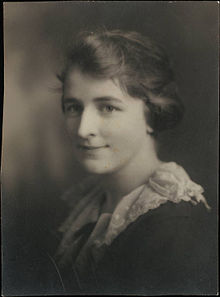Kathryn Hulme
Kathryn Hulme , full Kathryn Cavarly Hulme , (born July 6, 1900 in San Francisco , † August 25, 1981 in Līhuʻe , Kauai ) was an American writer . Best known is her novel The Story of a Nun , which appeared in 1956 and was also made into a film in 1959.
Biographical
Kathryn Hulme was the daughter of Julia Frances Cavarly Hulme and Edwin Page. After attending the University of California from 1918 to 1921 and Columbia University in 1922, she attended Hunter College in 1923 . After college, she worked as a reporter for the Daily Californian . She lived in Paris in the 1930s , but returned to America when the Second World War broke out , where she accepted a job as a welder in a shipyard for the duration of the war. After the war she went to Germany and got involved in various aid projects for refugees in the occupied zone.
In the early 1950s she moved back to the United States, where she settled with Marie Louise Habets , whose experiences she dealt with in her best-known novel, first in Connecticut, then in Southern California and finally on the Hawaiian island of Kauai. In 1951 she was baptized into the Roman Catholic Church .
In Phoenix , Marie Louise Habets had lost a job as a nurse when the administration found out that she was a former nun. Habets suggested to Kathryn Hulme to put her story on paper somewhat alienated, maybe this could "at least do something good". Hulme's book Tale of a Nun quickly became a bestseller. The film adaptation with Audrey Hepburn in the leading role was nominated for an Oscar . This novel Hulmes has often been mistaken for semi-autobiographical, but in fact it depicts the life story of Marie Louise Habets , a Belgian nun . In her own, somewhat alienated autobiography from 1938, We Lived as Children , Hulme describes life in San Francisco after the great earthquake of 1906 from the perspective of a child.
Another work by Hulmes, The Undiscovered Country: A Spiritual Adventure , portrays her student work with the Greek-Armenian philosopher and mystic G. I. Gurdjieff , which ultimately led to her conversion to the Roman Catholic Church.
Kathryn Hulme is also the author of Wild Place , in which she describes her experiences as the director of a UNRRA camp for Polish refugees in Wildflecken , Germany, after the Second World War . This book won the Atlantic Non-Fiction Award in 1992 . In Wildflecken Hulme also met the Belgian nurse Marie Louise Habets, who had previously been a religious. The story of a nun is a slightly alienated version of Habets' experiences in religious life. For this work, Hulme was awarded the Brotherhood Award of the National Conference of Christians and Jews .
Catalog raisonné
- How's the Road (self-edited), 1928
- Arab Interlude , Macrae Smith Company (Philadelphia), 1930
- Desert Night , The Macauley Company (New York), 1932
- We lived as children , AA Knopf (New York, London), 1938
- The Nun's Story , Pocket Books, 1958
- Annie's Captain , Little, Brown and Company (Boston, Toronto), 1961
- The Undiscovered Country: A Spiritual Adventure , Little, Brown & Co. (Boston, Toronto), 1967; Reissued Lexington MA, 1997
- Look A Lion In the Eye: On Safari Through Africa , Little, Brown & Co. (Boston, Toronto), 1974
Individual evidence
- ↑ Debra Campbell, The Nun and the Crocodile: The Stories within The Nun's Story , American Academy of Religion Annual Meeting, 2004
- ↑ Debra Campbell, The Nun and the Crocodile: The Stories within The Nun's Story , American Academy of Religion Annual Meeting, 2004
- ^ The Rope
Web links
- Kathryn Hulme Papers Digital work collection from the beincke Rare Book and Manuscript Library
- Hulme, Kathryn, in: Women in World History: A Biographical Encyclopedia
| personal data | |
|---|---|
| SURNAME | Hulme, Kathryn |
| ALTERNATIVE NAMES | Hulme, Kathryn Cavarly (full name) |
| BRIEF DESCRIPTION | American writer |
| DATE OF BIRTH | July 6, 1900 |
| PLACE OF BIRTH | San Francisco |
| DATE OF DEATH | August 25, 1981 |
| Place of death | Lihu'e , Kauai |
